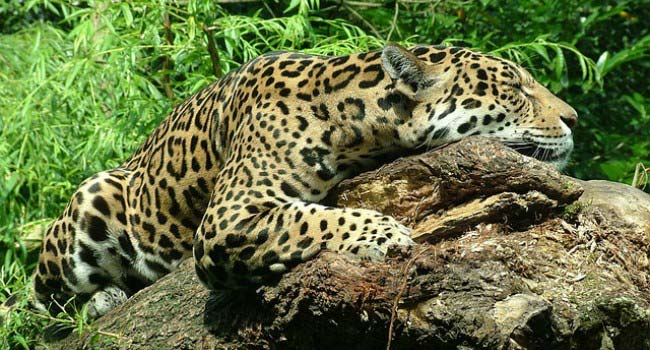
Brazil is world-famous for its amazing biodiversity. The country is home to around 60 per cent of the Amazon rainforest, which in turn provides a home to around 10 per cent of all species found on Earth. Brazil is also ranked first for the highest number of different plants (55,000 species), fish (3000 species), and mammals (at over 689 species). On top of all this, Brazil is ranked second for reptile biodiversity (744 species) and third for avian biodiversity (1832 different bird species). With such impressive biodiversity it can be quite hard to pick a single favourite, which is why we’ve narrowed it down to our top 5 coolest animals you can see in Brazil. Some of these you might quite like to see, others you may want to steer clear of – either way these are all animals you can see when you relocate to Brazil with Santa Fe.
Jaguars (Panthera onca)

There are few animals as majestic as the jaguar. While they once roamed the entire southern continent (and can still be found as far north as Arizona) the Jaguar is now a near-threatened species with numbers in constant decline. As the third largest feline species in the world, the jaguar features quite prominently in ancient, local mythology as the fierce and solitary predator it is. It can even bite through the shell of the giant armadillo, though it generally kills by crushing skulls with its powerful jaws.
Despite what domestic cats in your home country may have taught you, not all cats hate water – the jaguar is, in fact, quite fond of swimming.
Giant Armadillos (Priodontes maximus)

Giant armadillos are exactly what they sound like – an armadillo that can grow up to an impressive 80kg, measuring 1.5m from nose to tail. These mammals are interesting not just for their well-known defence mechanism, but also for the fact that they have around 80-100 teeth – that’s more teeth than any other terrestrial mammal. What does it need those teeth for? Eating everything from ants and termites to spiders and snakes.
You might not have thought it capable, looking at how small they look in photographs, but remember that they are about as tall as (and can weigh as much as) any one person in your office.
Giant Anteaters (Myrmecophaga tridactyla)

Giant anteaters are also known as ant bears, growing up to around 2m in length and 40kg in weight. How does the giant anteater get so giant, especially considering it eats ants, you may be wondering. Your average ant bear will spend about one minute at an ant nest before being driven away by bites and stings. It does this once per nest up to 200 times in a day. That’s a whopping 30,000 insects’ worth of protein and carbohydrates eaten per day, which is how it maintains its massive size.
Anacondas (Eunectes spp.)

Brazil is home to three different species of anaconda – the green anaconda, the yellow anaconda and the darky-spotted anaconda, or E. murinus, E. notaeus and E. deschauenseei respectively. The green anaconda is the largest of the three, and is often described as the largest snake on the planet.
Anacondas have been recorded at sized of up to 9m long, with weights going as high as 70kg, though folklore and historical reports alike claim that these snakes can grow up to 30m in length.
Piranhas (Characidae spp.)

Piranhas are easily Brazil’s best-known fish, mostly for their flesh-eating ways. At around 14-26cm long, piranhas are fairly large. Despite a reputation for being fierce predators which hunt as a school, they are actually quite timid. This being said, we still suggest you give them a wide berth, unless you’re after eating them yourself – piranhas are often eaten as a local delicacy.

